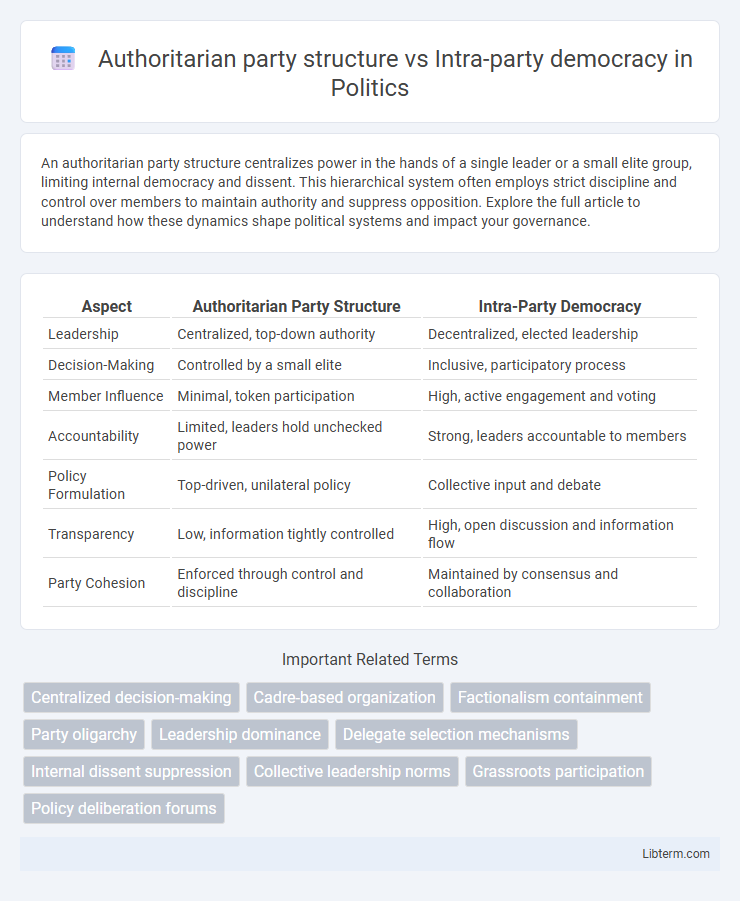An authoritarian party structure centralizes power in the hands of a single leader or a small elite group, limiting internal democracy and dissent. This hierarchical system often employs strict discipline and control over members to maintain authority and suppress opposition. Explore the full article to understand how these dynamics shape political systems and impact your governance.
Table of Comparison
| Aspect | Authoritarian Party Structure | Intra-Party Democracy |
|---|---|---|
| Leadership | Centralized, top-down authority | Decentralized, elected leadership |
| Decision-Making | Controlled by a small elite | Inclusive, participatory process |
| Member Influence | Minimal, token participation | High, active engagement and voting |
| Accountability | Limited, leaders hold unchecked power | Strong, leaders accountable to members |
| Policy Formulation | Top-driven, unilateral policy | Collective input and debate |
| Transparency | Low, information tightly controlled | High, open discussion and information flow |
| Party Cohesion | Enforced through control and discipline | Maintained by consensus and collaboration |
Defining Authoritarian Party Structure
Authoritarian party structure is characterized by centralized control, top-down decision-making, and limited political pluralism within the party, often suppressing dissent and internal debate to maintain strict leadership dominance. Unlike intra-party democracy, which emphasizes participatory decision-making, transparent processes, and member influence on policy and leadership selection, authoritarian structures restrict member engagement and concentrate power in a small elite. This hierarchy ensures unified messaging and policy implementation but at the cost of internal accountability and diverse representation.
Understanding Intra-Party Democracy
Intra-party democracy promotes member participation, transparency, and accountability within political organizations, fostering open debates and policy discussions that contrast sharply with authoritarian party structures centered on top-down control and limited member influence. Understanding intra-party democracy requires analyzing mechanisms such as candidate selection processes, leadership elections, and policy formulation that empower ordinary members and encourage collective decision-making. Research highlights that robust intra-party democracy enhances party legitimacy, responsiveness to constituents, and adaptability in dynamic political environments.
Historical Evolution of Party Organization
Authoritarian party structures historically centralized power within a small elite, limiting grassroots participation and decision-making to maintain strict control over political outcomes. Intra-party democracy evolved as parties responded to pressures for greater transparency and member involvement, promoting institutional mechanisms such as internal elections, policy debates, and accountability processes. The shift from authoritarianism to intra-party democracy reflects broader democratic transitions and the increasing demand for political inclusivity and organizational legitimacy.
Decision-Making Processes Compared
Authoritarian party structures centralize decision-making power within a small elite, limiting member participation and enforcing top-down directives, which often results in rapid but less transparent policy implementation. Intra-party democracy emphasizes decentralized decision-making, allowing broader member involvement through voting, debates, and consensus-building, fostering transparency and legitimacy but occasionally slowing the process. The contrast in decision-making processes directly impacts party cohesion, responsiveness, and adaptability to political challenges.
Leadership Selection Mechanisms
Authoritarian party structures centralize leadership selection, often relying on top-down appointments or opaque criteria controlled by a small elite, limiting member influence and promoting stability through uniformity. In contrast, intra-party democracy incorporates competitive elections, transparent procedures, and wider member participation, enhancing accountability and responsiveness within leadership selection mechanisms. These divergent approaches significantly impact party cohesion, responsiveness to public demands, and overall political legitimacy.
Member Participation and Engagement
Authoritarian party structures limit member participation by concentrating decision-making power within a small elite, reducing opportunities for grassroots engagement and dissent. Intra-party democracy promotes active member involvement through transparent processes, open debates, and elections that empower members to shape party policies and leadership. Higher levels of member participation in democratic parties enhance accountability and responsiveness, fostering a stronger connection between the party and its base.
Policy Formation and Internal Debate
Authoritarian party structures centralize policy formation, limiting internal debate to a select leadership cadre, which often results in uniform and expedited decision-making but suppresses diverse viewpoints. Intra-party democracy encourages broader member participation in policy discussions, fostering a dynamic environment where competing ideas can be debated openly, enhancing policy legitimacy and adaptability. The tension between these models reflects a trade-off between efficiency and inclusivity in political party governance.
Accountability and Transparency Within Parties
Authoritarian party structures often lack accountability and transparency, concentrating power in the hands of a few leaders who make decisions without broad consultation or oversight. In contrast, intra-party democracy promotes mechanisms such as regular elections, open debates, and member participation, enhancing both accountability and transparency within party operations. Effective intra-party transparency ensures leaders are answerable to members, reducing the risk of corruption and reinforcing internal legitimacy.
Impacts on Electoral Success and Governance
Authoritarian party structures centralize decision-making power, often limiting internal dissent and streamlining electoral campaigns, which can enhance electoral success through disciplined candidate selection and resource allocation. Intra-party democracy fosters broader participation and debate, potentially increasing public legitimacy and policy responsiveness, but it may also create factionalism that complicates unified campaign strategies and governance cohesion. Balancing these dynamics, authoritarian systems may achieve short-term electoral advantages, while intra-party democratic systems often promote sustainable governance through inclusive decision-making and adaptability.
Global Case Studies and Contemporary Trends
Authoritarian party structures maintain centralized control, limiting intra-party democracy by restricting member participation and dissent, as seen in China's Communist Party and Russia's United Russia. In contrast, intra-party democracy fosters grassroots engagement and competitive candidate selection, exemplified by the African National Congress in South Africa and the Indian National Congress. Contemporary trends reveal hybrid models where authoritarian regimes adopt limited intra-party reforms to enhance legitimacy without ceding full control, evident in Vietnam and Cuba's political adaptations.
Authoritarian party structure Infographic

 libterm.com
libterm.com